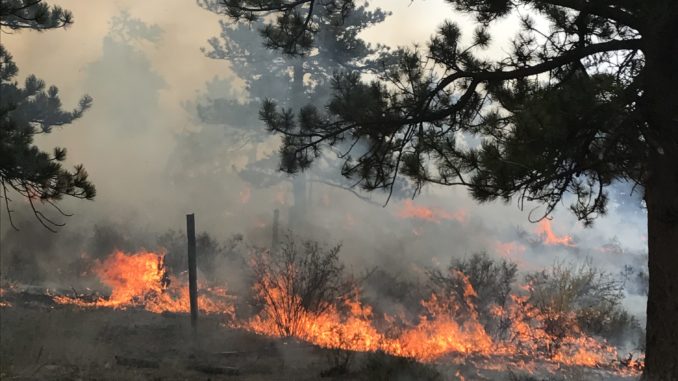
By The Coalition for the Poudre River Watershed
This summer, wildfires across southern and western Colorado are providing a stark reminder of how large, high intensity wildfires can affect our communities and watersheds. Our hearts go out to the communities that are living with the impacts of these fires, including loss of homes and property as well as the damaging effects to water supplies, recreation, habitat and other values. The wildfires currently burning in Colorado demonstrate the importance of the work we need to do to reduce those impacts before they happen. To better understand how to help our forests become healthier, we need to better understand our forests.
Wildfire’s role in shaping our Northern Colorado landscape
Fires have always been an essential part of healthy forests, playing an integral role in the structure and composition of many ecosystems. Although mechanical treatments (using chainsaws and heavy equipment) can help with forest restoration, it cannot replace the valuable ecological work that fire does for our forests. Fire “cleans house” so to speak, especially after years of fire suppression. This can reduce the frequency of high intensity wildfires that can have long-lasting, negative impacts on our watersheds and communities.
Imagine taking an ambitious hike from Eagle’s Nest Open Space near Livermore all the way to the headwaters of the Poudre River in Rocky Mountain National Park. At your starting point, you would see montane forests of ponderosa pine and Douglas fir. At this elevation, low intensity surface fires are a natural part of the ecosystem. These surface fires burn grass, pine needles, and dead wood; but rarely kill the older thick-barked trees.
As you hike to higher elevations (CSU Mountain Campus, for example) the landscape around you starts to change and become a Lodgepole pine forest. Like ponderosa pine, these forests also depend on fire. Lodgepole pine trees have closed cones that produce hundreds of thousands of seeds once a fire moves through. The bare mineral soil and ash produced by a fire provide an excellent seedbed for lodgepole pine seedlings to grow in the open sunshine.
Finally, as you near your high elevation destination near the headwaters of the Poudre, you will enter subalpine forests of spruce and fir. These cool, moist forests receive high snowfall, which remains well into the summer. This moisture helps make spruce-fir forests fire resistant. Studies of tree rings indicate a fire only once every 300 years or more.
As you have seen throughout your hike, forest vitality in the Cache la Poudre River watershed depends on fire. Fire is nature’s waste management system. It reduces dead timber to ash and in the process releases minerals back into the soil. Without fire, particularly in more arid ecosystems, dead material builds up creating a reservoir of potential fuel, also known as the “fuel load.” Fire can also create a diverse mosaic of tree age and species. Without fire, forests would not be able to support the diverse habitats required by many plant, bird and mammal species.
Human actions across the landscape have changed the ecological role of wildfire. We are working together with partners, including the US Forest Service, The Nature Conservancy, Colorado State Forest Service, Colorado Forest Restoration Institute and others to take action on the ground to help bring our forests back in balance with wildfire. To learn more, visit our website (poudrewatershed.org) and follow us on Facebook.
Upcoming Events
We are hosting a fun opportunity for people to learn more about our forests and the history and ecology of wildfire on Saturday, September 22nd from 10am-12pm at Gateway Natural Area. Join CPRW and our partners for a free field trip to learn more about how wildfires influence vegetation, wildlife and rivers. Email hallys@poudrewatershed for more information or to RSVP.
Did you know that the Cache la Poudre River is the only river in Colorado that is designated as Wild and Scenic?
This year is the 50th Anniversary of the Wild & Scenic Act! CPRW, Wildlands Restoration Volunteers and the USFS will be organizing 2-3 short restoration projects in the Wild and Scenic corridor in the Poudre Canyon on Sunday, September 16th. The morning restoration project will be followed by a celebration at The Mishawaka with opportunities to have fun, learn about other conservation groups, and to listen to live music. Email hallys@poudrewatershed for more information.
Interested in volunteering on a forest restoration project? Contact weston@poudrewatershed for opportunities this fall.
The Coalition for the Poudre River Watershed is a local non-profit whose mission is to improve and maintain the ecological health of the Poudre River watershed through community collaboration. For more information visit www.poudrewatershed.org or email [email protected]
Support Northern Colorado Journalism
Show your support for North Forty News by helping us produce more content. It's a kind and simple gesture that will help us continue to bring more content to you.
BONUS - Donors get a link in their receipt to sign up for our once-per-week instant text messaging alert. Get your e-copy of North Forty News the moment it is released!
Click to Donate
